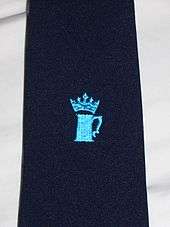King Street Run

The King Street Run is a bi-annual combined run and pub crawl in Cambridge, England.[1] It takes place along King Street. One of the pubs visited is now named after the event.[2]
History
One evening in Michaelmas term of 1955 in the Criterion bar in Market Passage a discussion took place between three undergraduates of St John’s College, all either Royal Navy or Royal Marines, and a group of medical students of unknown college affiliation. The discussion centred on the drinking capacity of the human male, one of the medical students asserting that the male bladder could hold no more than four pints. The St John’s students disagreed in principle and the group agreed to settle the argument by meeting on a specified evening and having a drink in every pub on King Street.
Starting at the Duke of Cambridge in Short Street, the St John’s students made their way westwards via the six existing pubs in King Street, before ending up at the Prince of Wales in Hobson Street. For some reason the medical students failed to show, but the John's students picked up a friend in the Criterion who was already been on his second or third pint and managed a further ten pints before he needed to relieve himself – settling the argument to one party’s satisfaction at least.
Shortly after the King Street Pint to Pint Club was formally constituted, with the basic objective drinking a pint of ale in seven of the street’s pubs before returning for an eighth in the pub you started in. The club set rules to be observed for the duration of drinking, among which was a penalty pint awarded for the commission of either of the two Ps, “peeing or puking”. Successful members of the club wore a special tie. It was plain navy blue, decorated with the image of a tankard surmounted by a crown (its design taken from the Royal Navy’s own emblem), both of which were machine-stitched in light blue. A tie that bore an embroidered letter ‘P’ (in either pee yellow or puke green) indicated that the bearer had incurred a penalty pint in the course of completing the run. The tie soon became a highly sought after item of apparel.[3]
The King Street Pint to Pint Club was banned in 1964 by Cambridge University proctors,[4] but was restarted in the mid/late 1970's by the Sir Reginald Kell society active at that time. During the Sir Reginald Kell period, additional rules were added: ladies were allowed halves or shorts; drinks could not be set up in advance and if you met a friend you were honour bound to have a chat with them. At the time the run was not a race and entrants had two hours to complete it, though the penalty pint rule was retained. Many years later the King Street Run provided the inspiration for the start of the annual Hilton Harriers Hick and Hurl Christmas Social/Charity Run in South Africa.
The Sir Reginald Kell era of the run (which definitely included 1978/1979) must have been short-lived as the Cantabrigensis Hash House Harriers resurrected the run in 1982,[5][6] and ran the event every two years with some modifications to the original rules, the main objective being to down eight pints of a different variety of beer (which meant “doubling up” in three of the five remaining King Street pubs) within a one-hour time limit. Penalty pints were replaced by instant disqualification for peeing or puking. The King Street Run tie - to the same design as the original - continued to be awarded to anyone who completed the course within the time limit. The current record is 14 min 05 sec held by John Philips of the Cambridge Hash House Harriers.[7][8]
The pubs (current)
- The King Street Run, named after the run itself. Formerly the Horse and Groom, in existence since at least 1830, so the oldest extant pub on the street;
- The Champion of the Thames, a pub since the late 1860s
- St Radegund, originally The Rhadegund after the sixth-century saint, Radegund;
- The Cambridge Brew House, formerly The Bun Shop, and before that The Royal Arms
See also
References
- ↑ "Cambridge History - a personal view". Retrieved 20 May 2007.
- ↑ "The truth is out there". Cambridge Evening News. 15 May 2007. Retrieved 20 May 2007.
- ↑ Steven Haslemere (2008). The Ascent of Mount Hum. Signal Books Ltd. ISBN 978-1-904955-48-1.
- ↑ Esther Oxford, John Windsor (1995-02-09). "University challenged". The Independent (London). Retrieved 20 May 2007.
- ↑ "Cambridge Hash House Harriers 1000th Run". Retrieved 20 May 2007.
- ↑ Steven Haslemere (2008). The Ascent of Mount Hum. Signal Books Ltd. ISBN 978-1-904955-48-1.
- ↑ Cambridge Hash House Harriers 1000th run magazine
- ↑ Steven Haslemere (2008). The Ascent of Mount Hum. Signal Books Ltd. ISBN 978-1-904955-48-1.
External links
- Cambridge Pub Guide: Kite and King Street
- Cantabrigensis Hash House Harriers
- King Street Run pub crawl on BarCrawl
Coordinates: 52°12′25″N 0°07′23″E / 52.207°N 0.123°E